A Framework for Planning and Evaluating the Role of Urban Stream Restoration for Improving Transportation Resilience to Extreme Rainfall Events
Abstract
1. Introduction
2. Methods
2.1. Case Study Site
2.2. Proposed Evaluation Approach
- 1.
- Crossings Modified: All the stream crossing structures in the model were modified to a size that would eliminate any flow obstruction (i.e., culverts were replaced with elevated bridges spanning the channel). No changes were made to the channel geometry or floodplain extent. This scenario was intended to gauge the influence of undersized crossings on flooding.
- 2.
- Floodplain Restoration Only: Stream and floodplain restoration was applied to the entire reach of stream. No changes were made to the road crossings. This scenario was included to gauge the flood reduction that can be achieved by restoration alone.
- 3.
- Restoration and Crossing Modified: Floodplain restoration combined with increased hydraulic capacity of all crossings (i.e., the crossings were enlarged to eliminate flow obstructions). This scenario represents the maximum possible reduction in flooding and provides a benchmark to compare other scenarios against.
- 4.
- Restoration for Resilience to Extreme Events: Stream and floodplain restoration combined with strategic modifications of important, high-use crossings (i.e., culverts replaced with bridges spanning the floodplain) and the complete removal of less-used, higher-risk crossings. This scenario is designed as an approach to maintain transportation access during extreme events, reduce risk to the public, minimize future flood damage and reduce long-term maintenance costs.
2.3. Case Study Hydraulic Model
2.4. Model Calibration
2.5. Stream and Floodplain Restoration
3. Results
3.1. Crossings Modified
3.2. Floodplain Restoration Only
3.3. Restoration and Crossings Modified
3.4. Restoration for Resilience to Extreme Events
4. Discussion
5. Conclusions
Author Contributions
Funding
Acknowledgments
Conflicts of Interest
References
- Ashley, S.T.; Ashley, W.S. Flood fatalities in the United States. J. Appl. Meteorol. Climatol. 2008, 47, 805–818. [Google Scholar] [CrossRef]
- Haynes, R.; Coates, K.; Leigh, L. Shelter-in-place’ vs. evacuation in flash floods. Environ. Hazards Hum. Policy Dimens. 2009, 8, 291–303. [Google Scholar] [CrossRef]
- Walsh, J.; Wuebbles, D.; Hayhoe, K.; Kossin, J.; Kunkel, K.; Stephens, G.; Thorne, P.; Vose, R.; Wehner, M.; Willis, J.; et al. Our Changing Climate. In Climate Change Impacts in the United States: The Third National Climate Assessment; U.S. Global Change Research Program: Washington, DC, USA, 2014. [Google Scholar]
- US EPA. What Climate Change Means for North Carolina; U.S. Environmental Protection Agency: Washington, DC, USA, 2016.
- ASFPM. Dicussion Paper: Urban Flood Hazards: Challenges and Opportunities; Association of State Floodplain Managers: Madison, WI, USA, 2019. [Google Scholar]
- Bernhardt, E.S.; Palmer, M.A. Restoring streams in an urbanizing world. Freshwater Biol. 2007, 52, 738–751. [Google Scholar] [CrossRef]
- NOAA. Precipitation-Frequency Atlas of the United States. National Oceananic and Atmospheric Administration; Silver Spring, MD. 2006. Available online: https://hdsc.nws.noaa.gov/hdsc/pfds/pfds_map_cont.html?bkmrk=pa (accessed on 10 May 2019).
- USGS. The StreamStats Program. U.S. Geological Survey; 2019. Available online: http://streamstats.usgs.gov (accessed on 10 May 2019).
- Chester, M.; Allenby, B.; Markolf, S. How Cities Are Upgrading Infrastructure to Prepare for Climate Change, Smithsonian Magazine. October 2018. Available online: https://www.smithsonianmag.com/innovation/how-cities-are-upgrading-infrastructure-prepare-climate-change-180970600/ (accessed on 20 January 2020).
- Milly, P.; Betancourt, J.; Falkenmark, M. Stationarity Is Dead: Whither Water Management? Science 2008, 319, 573–574. [Google Scholar] [CrossRef] [PubMed]
- FEMA. Floodplain and Stream Restoration Fact Sheet; Federal Emergency Management Agency: Washington, DC, USA, 2017.
- Kenney, M.A.; Wilcock, P.R.; Hobbs, B.F.; Flores, N.E.; Martínez, D.C. Is Urban Stream Restoration Worth It? J. Am. Water Resour. Assoc. 2012, 48, 603–615. [Google Scholar] [CrossRef]
- Chou, R.J. Achieving successful river restoration in dense urban areas: Lessons from Taiwan. Sustainability 2016, 8, 1159. [Google Scholar] [CrossRef]
- Cockerill, K.; Anderson, W.P., Jr. Creating false images: Stream restoration in an urban setting. J. Am. Water Resour. Assoc. 2014, 50, 468–482. [Google Scholar] [CrossRef]
- Lammers, R.W.; Day, C. Urban River Restoration: Bringing Nature Back to Cities; Institute for the Built Environment, Colorado State University: Fort Collins, CO, USA, 2018. [Google Scholar]
- MRLC. The National Land Cover Database (NLCD). 2019; The Multi-Resolution Land Characteristics (MRLC) Consortium. Available online: https://www.mrlc.gov/ (accessed on 1 May 2019).
- NCFMP. North Carolina Flood Risk Information System; North Carolina Floodplain Mapping Program: Raleigh, NC, USA, 2019. Available online: https://fris.nc.gov/fris/Home.aspx?ST=NC (accessed on 1 May 2019).
- USACE. HEC-RAS Version 5.0; USACE Institute for Water Resources Hydrologic Engineering Center: Davis, CA, USA, 2016. [Google Scholar]
- Moore, C.E.; Loheide, S.P.; Lowry, C.S.; Lundquist, J.D. Instream Restoration to Improve the Ecohydrologic Function of a Subalpine Meadow: Pre-implementation Modeling with HEC-RAS. J. Am. Water Resour. Assoc. 2014, 50, 1033–1050. [Google Scholar] [CrossRef]
- Adams, T.E.; Chen, S.; Dymond, R. Results from Operational Hydrologic Forecasts Using the NOAA/NWS OHRFC Ohio River Community HEC-RAS Model. J. Hydrol. Eng. 2018, 23, 04018028. [Google Scholar] [CrossRef]
- Yang, J.; Townsend, R.D.; Daneshfar, B. Applying the HEC-RAS model and GIS techniques in river network floodplain delineation. Can. J. Civ. Eng. 2006, 33, 19–28. [Google Scholar] [CrossRef]
- USACE. HEC-RAS River Analysis System Hydraulic Reference Manual; USACE Institute for Water Resources Hydrologic Engineering Center: Davis, CA, USA, 2016. [Google Scholar]
- North Carolina Emergency Management. QL2/QL1 LiDAR Collection; North Carolina Emergency Managemnt: Raleigh, NC, USA, 2018. Available online: https://sdd.nc.gov/SDD/docs/LidarSummary.pdf (accessed on 9 May 2020).
- Chow, V.T. Open Channel Hydraulics; McGraw-Hill: New York, NY, USA, 1959. [Google Scholar]
- USGS. Guidelines for Determining Flood Flow Frequency; U.S. Geological Survey: Reston, VA, USA, 1981.
- Maurer, E.P.; Kayser, G.; Doyle, L.; Wood, A.W. Adjusting Flood Peak Frequency Changes to Account for Climate Change Impacts in the Western United States. J. Water Resour. Plan. Manag. 2018, 144, 05017025. [Google Scholar] [CrossRef]
- Rosgen, D.L. A Geomorphological Approach to Restoration of Incised Rivers. In Proceedings of the Conference on Management of Landscapes Disturbed by Channel Incision, Oxford, MS, USA, 19–23 May 1997; Wang, S.S.Y., Langendoen, E.J., Shields, F.D., Eds.; University of Mississippi: Oxford, MS, USA, 1997. [Google Scholar]
- Doll, B.A.; Wise-Frederick, D.E.; Buckner, C.M.; Wilkerson, S.D.; Harman, W.A.; Smith, R.E.; Spooner, J. Hydraulic geometry relationships for urban streams throughout the Piedmont of North Carolina. J. Am. Water Resour. Assoc. 2002, 38, 641–651. [Google Scholar] [CrossRef]
- Doll, B.A. Stream Restoration Technical Guidebook and Coastal Stream Study Amendment; Final report to N.C; Department of Environment and Natural Resources, Division of Water Quality: Raleigh, NC, USA, 2003.
- Doll, B.A.; Grabow, G.L.; Hall, K.R.; Halley, J.; Harman, W.A.; Jennings, G.D.; Wise, D.E. Stream Restoration: A Natural Channel Design Handbook; North Carolina State University: Raleigh, NC, USA, 2003. [Google Scholar]
- Inc. Autocad Civil3D 2019; Autodesk: San Rafeal, CA, USA, 2018. [Google Scholar]
- Wilby, R.L.; Keenan, R. Adapting to flood risk under climate change. Prog. Phys. Geogr. Earth Environ. 2012, 36, 348–378. [Google Scholar] [CrossRef]
- Opperman, J.J.; Moyle, P.B.; Larsen, E.W.; Florsheim, J.L.; Manfree, A.D. Floodplains: Processes and Management for Ecosystem Services; University of California Press: Oakland, CA, USA, 2017. [Google Scholar]
- Conine, A.; Xiang, W.N.; Young, J.; Whitley, D. Planning for multi-purpose greenways in Concord, North Carolina. Landsc. Urban Plan. 2004, 68, 271–287. [Google Scholar] [CrossRef]
- Ranger, N.; Hallegatte, S.; Bhattacharya, S.; Bachu, M.; Priya, S.; Dhore, K.; Rafique, F.; Mathur, P.; Naville, N.; Henriet, F.; et al. An assessment of the potential impact of climate change on flood risk in Mumbai. Clim. Chang. 2011, 104, 139–167. [Google Scholar] [CrossRef]
- Parry, M.L. Assessing the Costs of Adaptation to Climate Change: A Review of the UNFCCC Estimates; International Institute for Environment and Development: London, UK, 2009; ISBN 1843697459. [Google Scholar]
- Schulz, A.; Zia, A.; Koliba, C. Adapting bridge infrastructure to climate change: Institutionalizing resilience in intergovernmental transportation planning processes in the Northeastern USA. Mitig. Adapt. Strateg. Glob. Chang. 2017, 22, 175–198. [Google Scholar] [CrossRef]
- Revi, A.; Satterthwaite, D.; Aragon-Durand, F.; Corfee-Morlot, J.; Knsi, R.; Pelling, M.; Roberts, D.; Solecki, W. Urban Areas in Climate Change, 2014: Impacts, Adaptation, and Vulnerability; Part A: Global and Sectoral Aspects; Contribution of Working Group II to the Fifth Assessment Report of the Intergovernmental Panel on Climate Change; Cambridge University Press: Cambridge, UK, 2013. [Google Scholar]
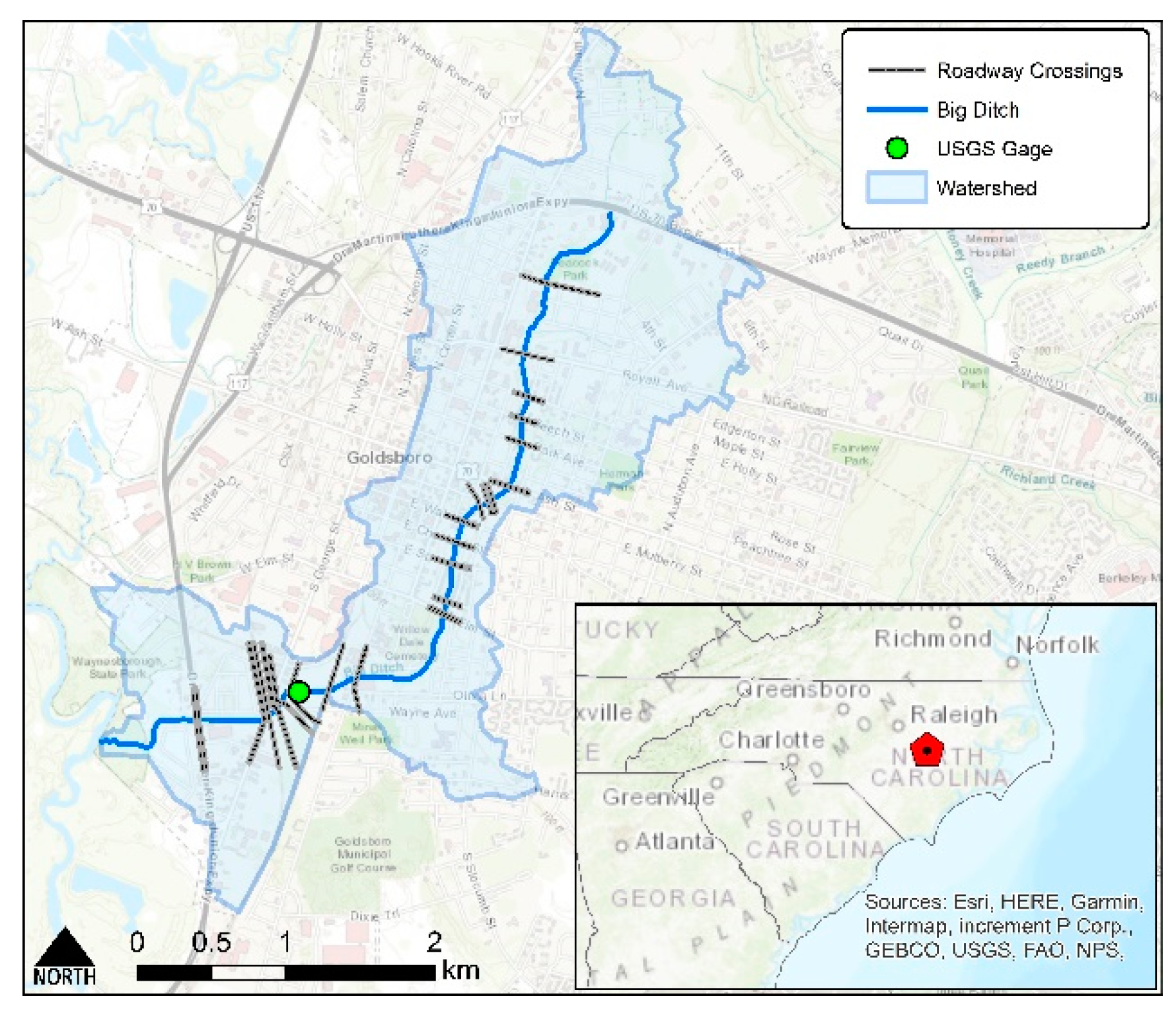
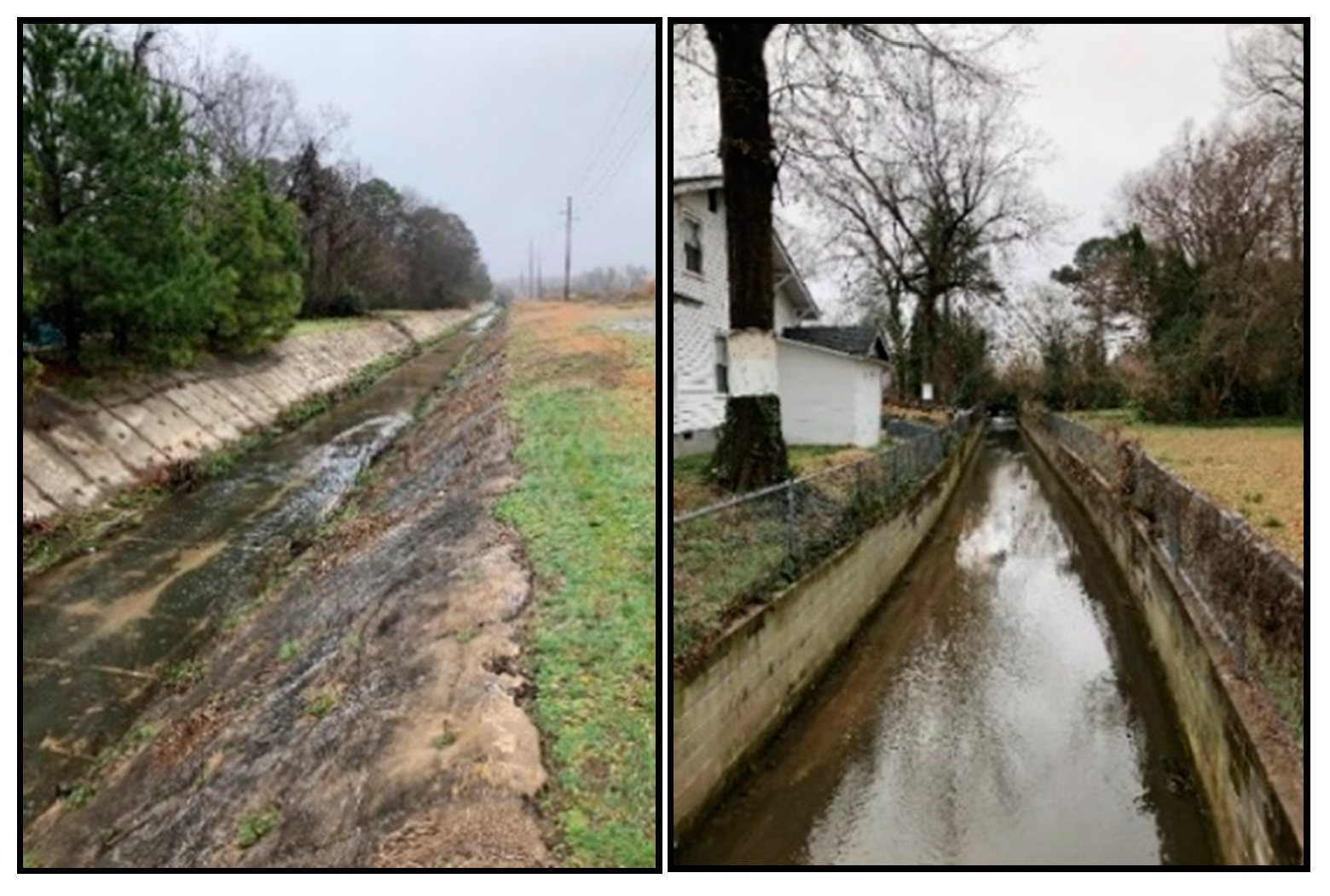
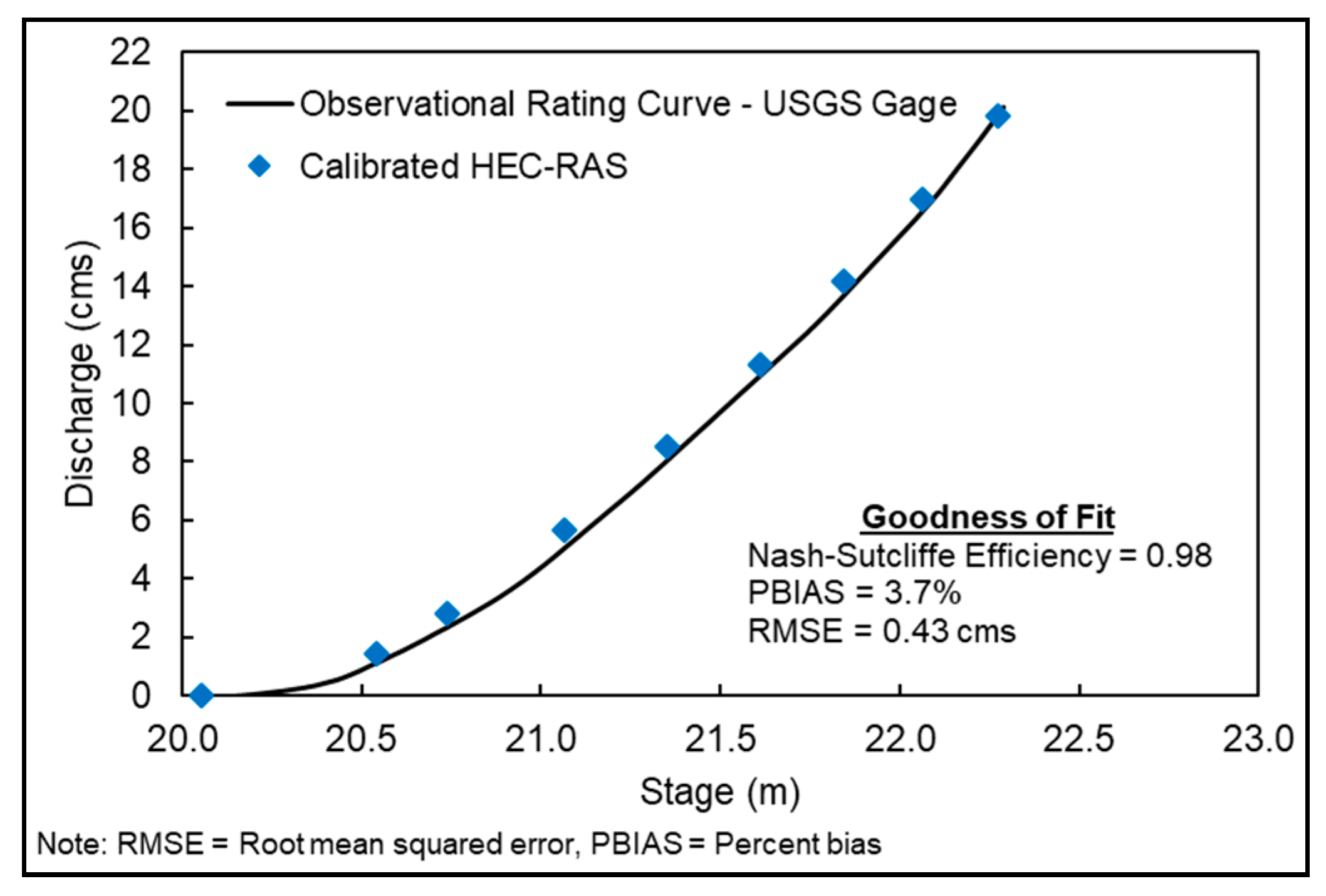
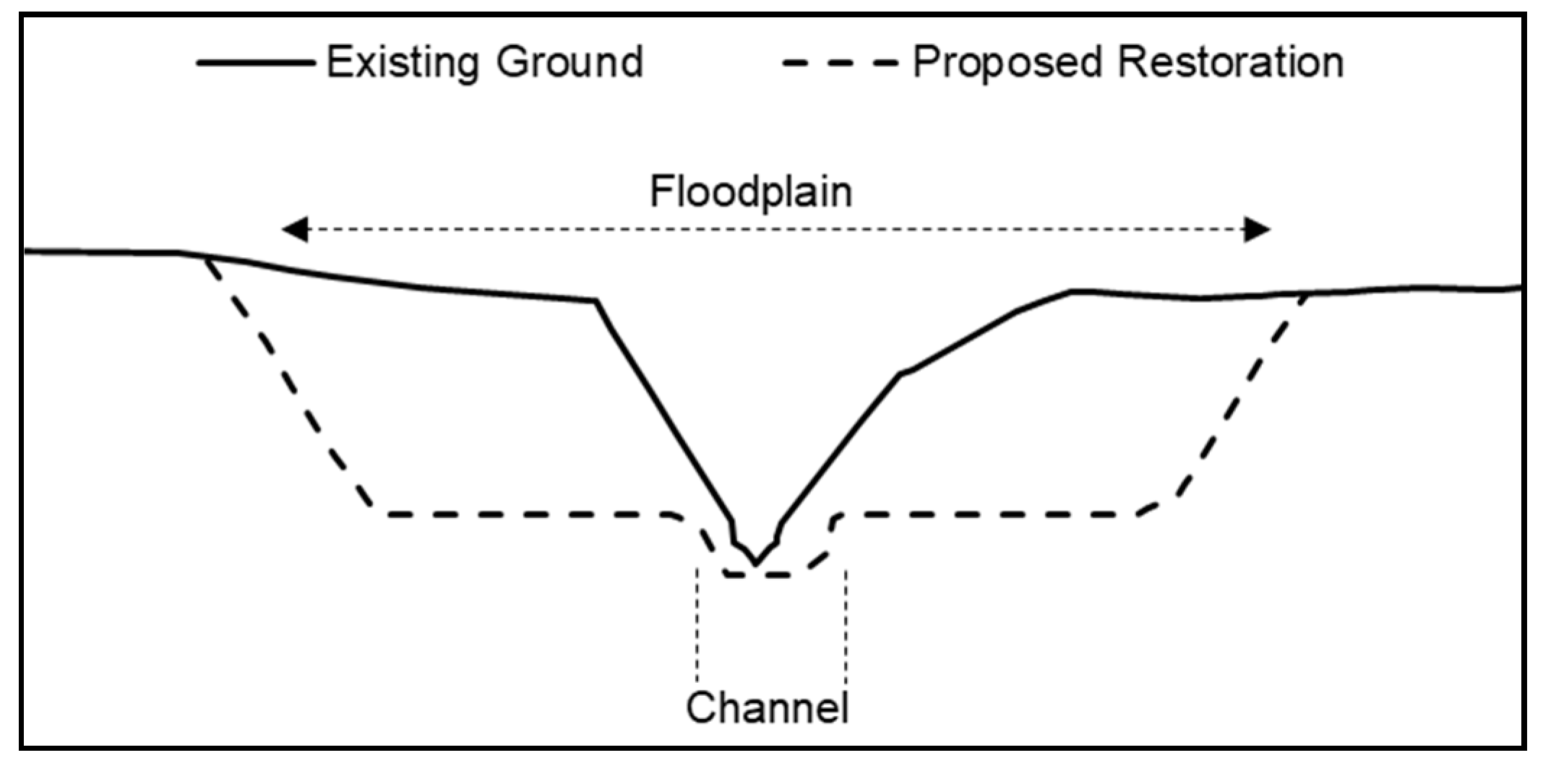




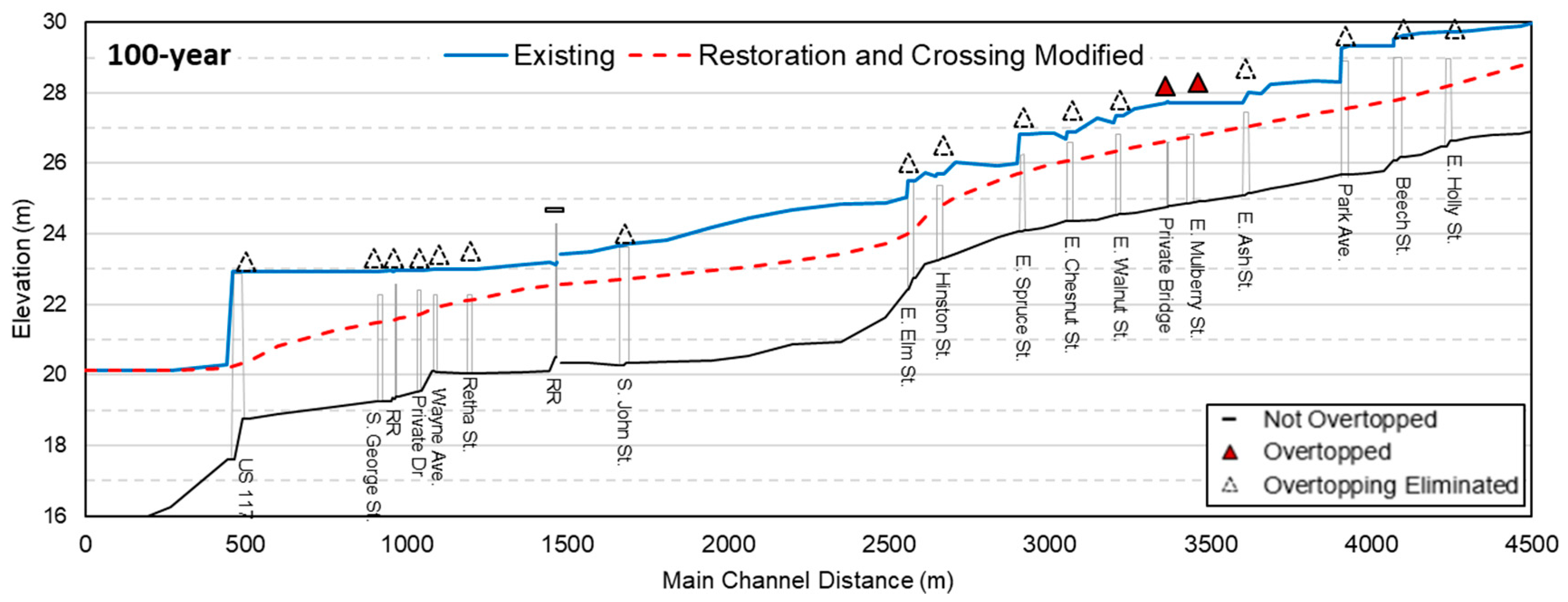
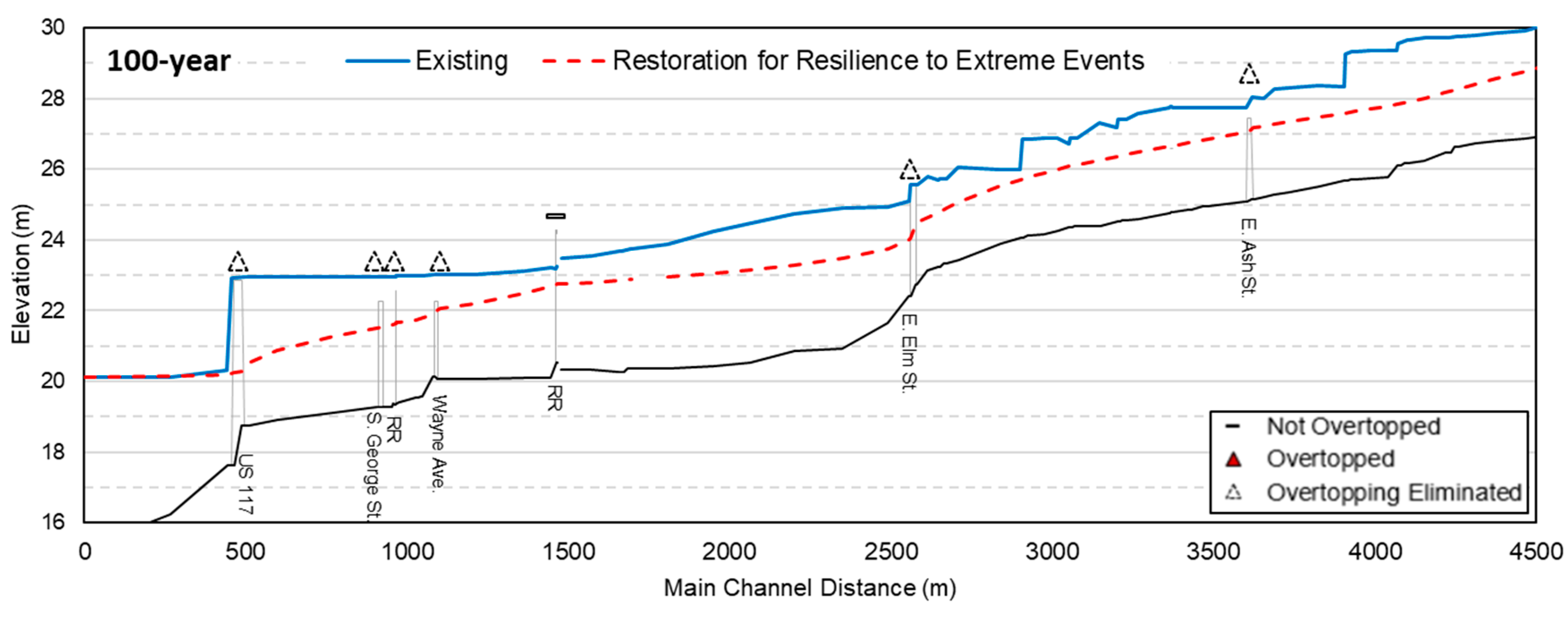
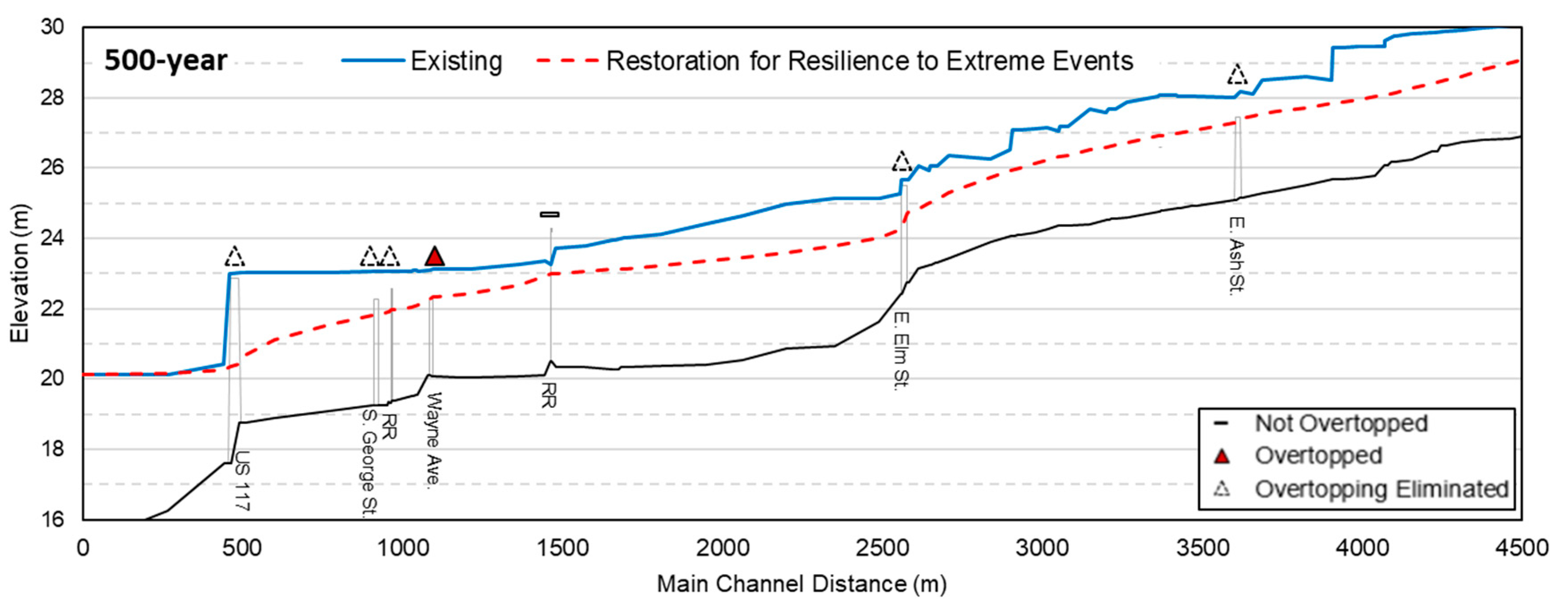
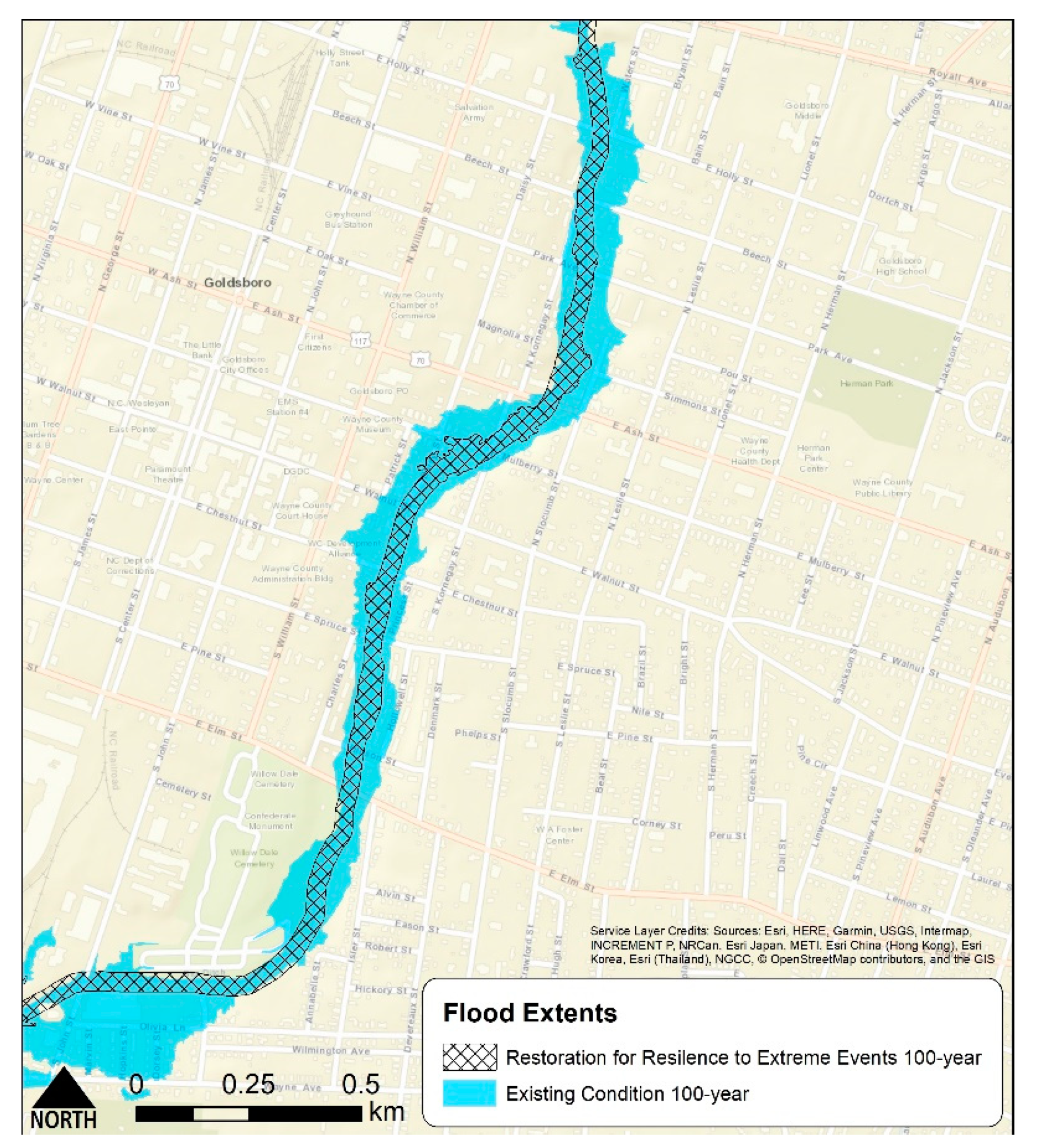
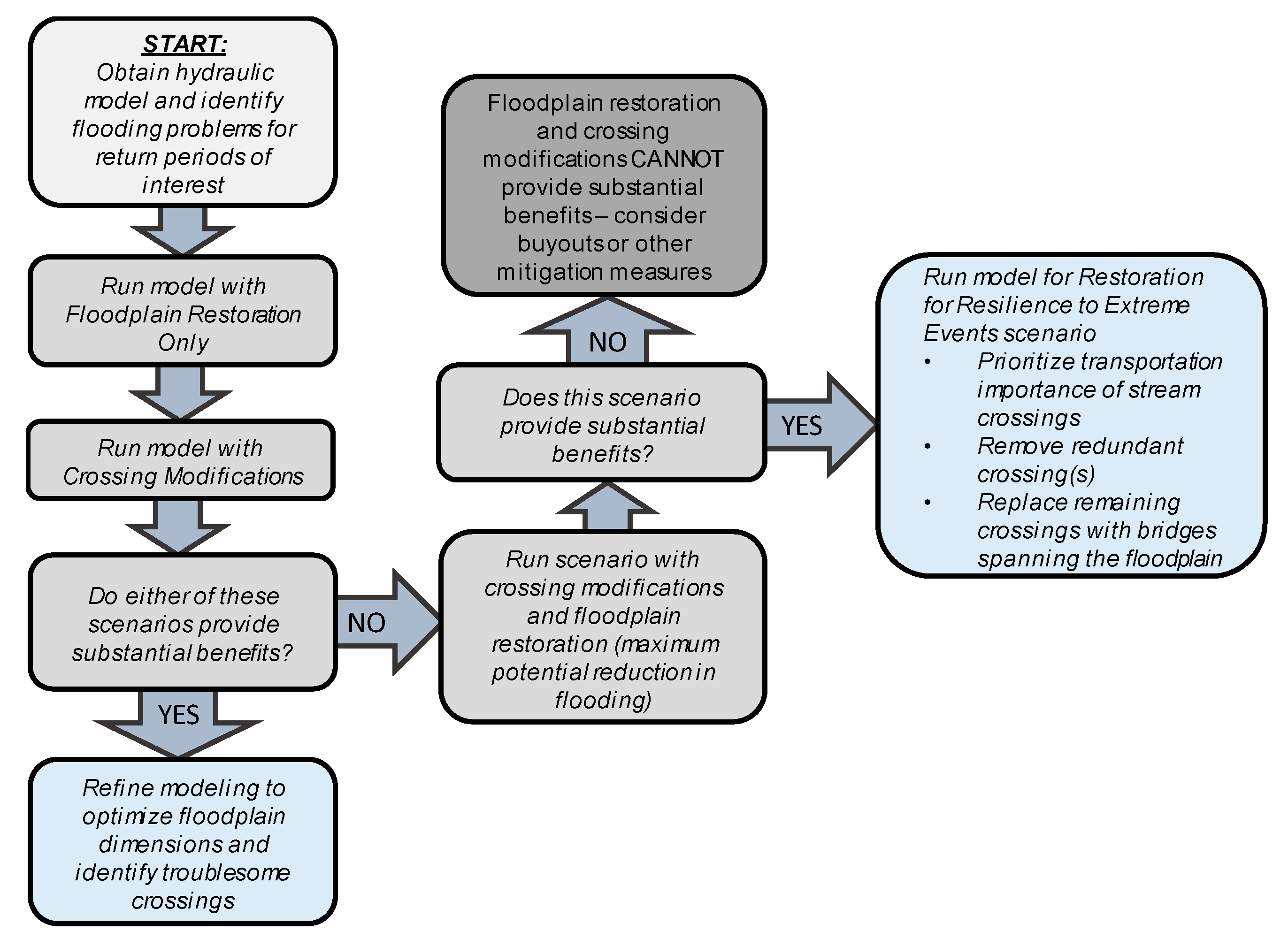
| Parameter | Description |
|---|---|
| Stream length in study area | 4.5 km |
| Model cross sections in study area | 67 |
| Bridges and culverts in study area | 19 |
| Channel area | 7.5–26 m2 |
| Manning roughness | 0.013–0.05 (channel) 0.058–0.12 (overbanks) |
| Average channel slope | 0.0017 m/m |
| Downstream boundary condition | Constant water surface elevation (20.1 m)—threshold for major flooding on the downstream Neuse River |
| Overbank elevation source | LiDAR DEM—150 cm spatial resolution, 9.25 cm vertical RMSE |
| Channel cross section elevation source | Detailed bathymetric cross section survey |
| Return Period | Model Discharge (cms) | |||||
|---|---|---|---|---|---|---|
| River Station (m) | 4500 | 4200 | 3600 | 2560 | 1200 * | |
| Drainage Area (km2) | 2.8 | 3.3 | 4.0 | 5.2 | 6.5 | |
| 10-year | ___________________ | 17.6 | 20.5 | 22.4 | 26.9 | 30.1 |
| 100-year | ___________________ | 30.9 | 34.9 | 38.8 | 46.1 | 51.8 |
| 500-year | ___________________ | 41.7 | 46.4 | 52.1 | 61.6 | 69.3 |
© 2020 by the authors. Licensee MDPI, Basel, Switzerland. This article is an open access article distributed under the terms and conditions of the Creative Commons Attribution (CC BY) license (http://creativecommons.org/licenses/by/4.0/).
Share and Cite
Doll, B.A.; Kurki-Fox, J.J.; Line, D.E. A Framework for Planning and Evaluating the Role of Urban Stream Restoration for Improving Transportation Resilience to Extreme Rainfall Events. Water 2020, 12, 1620. https://doi.org/10.3390/w12061620
Doll BA, Kurki-Fox JJ, Line DE. A Framework for Planning and Evaluating the Role of Urban Stream Restoration for Improving Transportation Resilience to Extreme Rainfall Events. Water. 2020; 12(6):1620. https://doi.org/10.3390/w12061620
Chicago/Turabian StyleDoll, Barbara A., J. Jack Kurki-Fox, and Daniel E. Line. 2020. "A Framework for Planning and Evaluating the Role of Urban Stream Restoration for Improving Transportation Resilience to Extreme Rainfall Events" Water 12, no. 6: 1620. https://doi.org/10.3390/w12061620
APA StyleDoll, B. A., Kurki-Fox, J. J., & Line, D. E. (2020). A Framework for Planning and Evaluating the Role of Urban Stream Restoration for Improving Transportation Resilience to Extreme Rainfall Events. Water, 12(6), 1620. https://doi.org/10.3390/w12061620





